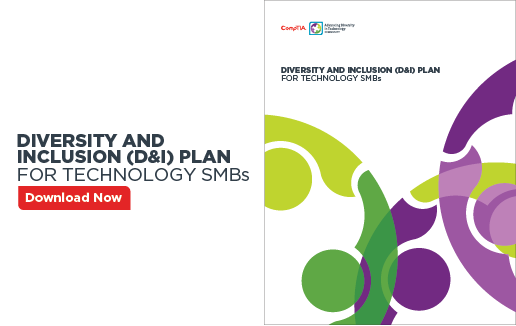
Study after study shows that diverse workplaces are highly impactful, driving productivity and profitability throughout the organization, according to CompTIA’s Diversity and Inclusion Plan for Technology Small Businesses.
According to the guide, which was released by CompTIA’s Advancing Diversity in Technology Community, “It’s clear that leaders who prioritize more diverse and inclusive workforces elevate the effectiveness of their businesses, the satisfaction of employees and their overall success.” The guide includes three important pieces for diversity and inclusion: Planning, acquisition and retention, and outlines the importance of inclusive cultures.
“I hear this comment in almost every discussion: ‘I hire the best person for the job,’” said CompTIA Community Leader Yvette Steele. “When it comes to hiring the best person for the job, hiring managers should set goals in the acquisition of diverse candidates and widen their perspective on what the best person looks like to ensure that they are getting their fair share of available top talent. Otherwise ‘best’ is defined by a selector who has biases that affect decision making.”
Look for Trends
The first step in planning for diversity at home is figuring out who works for you. Look at trends, like whether a particular department has a more homogeneous culture in regard to race, ethnicity, gender, age, veteran or disability status, or if there’s an area with a higher percentage of employees approaching retirement eligibility.
Rather than making sure there’s diversity represented in each department, look at stats like how often highly skilled and knowledgeable employees of diverse backgrounds are being offered promotions, transfers and other opportunities for advancement. “People stay at companies when there’s opportunity,” Steele said. “Having an inclusive company culture means getting out of old habits to offer more equal opportunities all around.”
Traditional moves like removing biased language from job descriptions and recruiting from colleges and universities with diverse populations remain important, but the D&I Plan for Technology SMBs goes further, recommending new strategies like offering staff opportunities to be trained specifically in recruitment and data analysis and developing a company-wide database to log previously screened and qualified resumes.
“This goes beyond creating a brand strategy to attract talent or placing job ads in publications catering to a diverse demographic,” Steele said.
Read CompTIA’s Diversity and Inclusion Plan for unexpected tips, like why engaging more people in your workforce planning and reviewing emerging trends of interest that can expand your diversity and inclusion efforts. The plan includes:
- A Diverse Workforce Talent and Acquisition Checklist, a three-year outline for drafting recruitment efforts.
- Deep dives from CompTIA members Doris Delgado, Ulysses Smith and Val Haskell into specific diversity and inclusion challenges, like troubleshooting D&I acquisition and retention.
Similar to the IT Security Community’s Security Assessment or the Blockchain Council’s Blockchain Decision Tree, the D&I plan is available to help small and medium-sized technology businesses clarify their needs and build out quality strategies for growth and innovation.
Why an Inclusive Culture Helps with Retention
CompTIA found that 3-in-10 nonwhite high-tech workers said they left a job because of a lack of diversity or hostile culture. “You have to look at your company culture and look for blind spots,” said Steele. “Getting great people to stay means adjusting your corporate culture.”
When you’re buying, consider supplier diversity, for example. Start with a small goal, like 10% of organizational spend for diverse suppliers, and identify areas for new suppliers to participate, like network support or hardware components, advises the D&I plan. Any investment you make have a with return in staff development, including mentoring the next generation and other new employees or an expanded network for your company to tap into.
There’s one thing to keep in mind with any diversity and inclusion effort: Your company should not try to represent itself as something it is not. “The worst thing that an organization can do is to be insincere,” Steele said.
If you’re going to make an effort to bring in people from different backgrounds, you need to provide all of your employees what they need to succeed. Employee resource groups (ERGs) usually go hand in hand with an organization’s inclusion and diversity goals, and can help you figure out what everybody needs.
If you’re in charge, this is on your plate. According to CompTIA research, about 70% of both high-tech and general business workers believe ultimate responsibility for workplace diversity lies with company leaders.
“Lots of people think that inclusion is a department or someone else’s job,” said Steele. “The fact is that inclusion is everyone’s job and cultures that welcome and respect difference enhance the performance of everyone on the team as the environment is more conducive for collaboration, creativity and engagement.”
Read CompTIA’s Diversity and Inclusion Plan. For more resources on diversity and inclusion, check out CompTIA’s Guide to Hiring Without Unconscious Bias and the Diversity Action Plan Workbook.

 Add CompTIA to your favorite RSS reader
Add CompTIA to your favorite RSS reader

